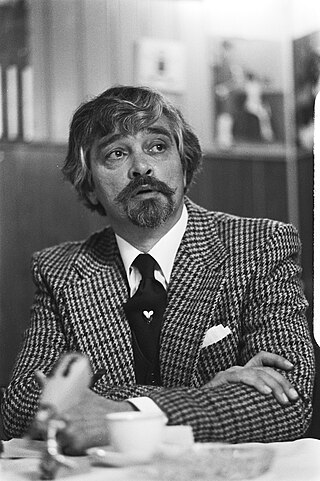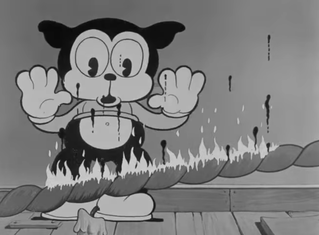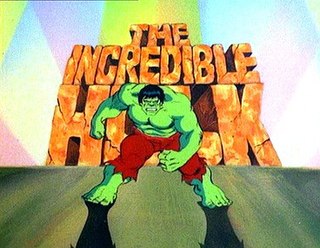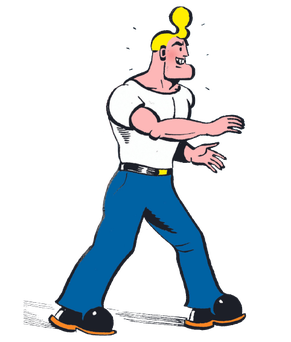
Oswald the Lucky Rabbit is an animated cartoon character created in 1927 by Walt Disney and Ub Iwerks for Universal Pictures. He starred in several animated short films released to theaters from 1927 to 1938. Twenty-seven animated Oswald shorts were produced at the Walt Disney Studio. After Universal took control of Oswald's character in 1928, Disney created a new character similar in appearance to Oswald as a replacement: Mickey Mouse, who went on to become one of the most famous cartoon characters in the world.

The golden age of American animation was a period that began with the popularization of sound synchronized cartoons in 1928 and gradually ended in the 1960s when theatrical animated shorts started to lose popularity to the newer medium of television. Animated media from after the golden age, especially on television, were produced on cheaper budgets and with more limited techniques between the late 1950s and 1980s.

Terrytoons was an American animation studio headquartered in New Rochelle, New York that produced animated cartoons for theatrical release from 1929 to 1973. It was founded by Paul Terry, Frank Moser, and Joseph Coffman, and operated out of the "K" Building in downtown New Rochelle. The studio created many cartoon characters including Fanny Zilch, Mighty Mouse, Heckle and Jeckle, Gandy Goose, Sourpuss, Dinky Duck, Little Roquefort, the Terry Bears, Dimwit, and Luno; Terry's pre-existing character Farmer Al Falfa was also featured often in the series.

Woody Woodpecker is a cartoon character that appeared in theatrical short films produced by the Walter Lantz Studio and Universal Animation Studio and distributed by Universal Pictures since 1940. Woody's last theatrical cartoon was produced by Walter Lantz in 1972.

Paulus Johannes "Paul" Biegel was a Dutch writer of children's literature.

The Inspector is an American series of 34 theatrical cartoon shorts produced between 1965 and 1969 by DePatie–Freleng Enterprises and released through United Artists. The cartoons are dedicated to an animated version of Inspector Clouseau comically battling against a rogues' gallery of internationally styled villains.

Johnny Bravo is an American animated comedy television series created by Van Partible for Cartoon Network. The second of the network's Cartoon Cartoons, it aired from July 14, 1997, to August 27, 2004. The titular Johnny Bravo, who is loosely based on Elvis Presley and James Dean, is a blonde-haired sunglasses-wearing, muscular, and dimwitted young man who lives with his mother and attempts to get women to date him, though he always falls short because of his actions. He ends up in bizarre situations and predicaments, often accompanied by celebrity guest characters such as Donny Osmond or Adam West. Throughout its run, the show was known for its adult humor and pop culture references.
Tom and Jerry is an American animated media franchise and series of comedy short films created in 1940 by William Hanna and Joseph Barbera. Best known for its 161 theatrical short films by Metro-Goldwyn-Mayer, the series centers on the enmity between the titular characters of a cat named Tom and a mouse named Jerry. Many shorts also feature several recurring characters.

KaBlam! is an American animated sketch comedy anthology television series that ran on Nickelodeon from October 11, 1996 to January 22, 2000, with repeats until November 2, 2001. The series was created by Robert Mittenthal, Will McRobb, and Chris Viscardi. The show was developed as a fully animated showcase for alternative forms of animation that were more common in indie films and commercials. Each episode thus features a collection of short films in different innovative styles of animation, bridged by the characters Henry and June, who introduce the short animations and have zany hijinks of their own in between.

Herman and Katnip is a series of theatrical cartoons featuring Herman the Mouse and Katnip the Cat, produced by Famous Studios in the 1940s and 1950s. Arnold Stang and Allen Swift were the regular voices of Herman, while Sid Raymond was the regular actor for Katnip, although one or both of the characters would occasionally be voiced by Jackson Beck and Jack Mercer, respectively.

K3 is a Belgian-Dutch girl group with a Dutch-language pop repertoire, consisting of Hanne Verbruggen, Marthe De Pillecyn, and Julia Boschman. In addition to music, they are also central to many cinema films, television series and musicals. The signature style and iconicity of K3 rely on all three girls mostly wearing the same outfit, and they are traditionally a redhead, a brunette, and a blonde. Throughout its career, K3 has built a space within Dutch and Belgian pop culture, becoming one of the most successful groups of the Benelux. The group's name is derived from the first letters of the three first members from 1998: Karen Damen, Kristel Verbeke, and Kathleen Aerts.

Rien Poortvliet was a Dutch artist and illustrator.

Bimbo's Initiation is a 1931 Fleischer Studios Talkartoon animated short film starring Bimbo and featuring an early version of Betty Boop with a dog's ears and nose. It was the final Betty Boop cartoon to be animated by the character's co-creator, Grim Natwick, prior to his departure for Ub Iwerks' studio.

The Incredible Hulk is an animated television series based on the Marvel Comics character of the same name. The series ran for 13 episodes on NBC in 1982, part of a combined hour with Spider-Man and His Amazing Friends.

Luc Zeebroek, better known as Kamagurka, is a Belgian cartoonist, playwright, comic strip artist, painter, comedian, comedic singer and television producer, known for the absurd nature of his work. He created various comic strip characters, but "Bert" is the most well known. He also writes the scenarios for Herr Seele's comic strip, Cowboy Henk.

Gnomes, originally published in Dutch in 1976 as Leven en werken van de kabouter, then released in English in 1977, is a fiction book written by Wil Huygen and illustrated by Rien Poortvliet. The book explains the life and habitat of gnomes in an in-universe fashion, much as a biology book would do, complete with illustrations and textbook notes.

Cowboy Henk is a Belgian absurd/surreal humour gag-a-day comic strip series drawn by Herr Seele and written by Kamagurka. It was originally published in the newspaper De Morgen, but later taken over by the magazine HUMO, in which it is still published today and for whom Henk is now their mascot. The series was in continuous syndication from 1981 until 2011. After the brief interruption it was continued again in the spring of 2013.
Nero is a Flemish comic book character and the main protagonist in Marc Sleen's long running comic book strip series The Adventures of Nero (1947–2002). He is one of the most recognizable comic book characters in Belgium and comparable to Lambik from the Suske en Wiske series by Willy Vandersteen.
Bert is a Belgian comic strip, written and drawn by Kamagurka, which appeared exclusively in the Flemish magazine HUMO since 1977. The cartoons have also been published in the Dutch magazine Vrij Nederland, the French magazine Charlie Hebdo and the US magazine RAW. The series' protagonist, Bert, is Kamagurka's most recognizable character.

Clara Cleymans is a Belgian actress and musical theatre singer.


















